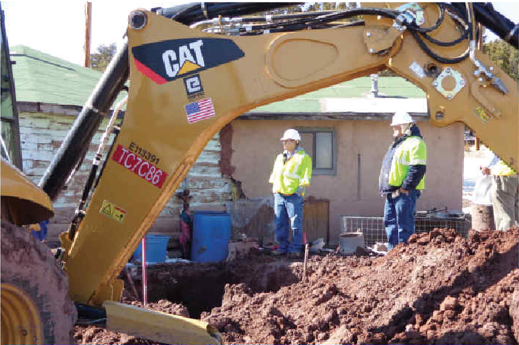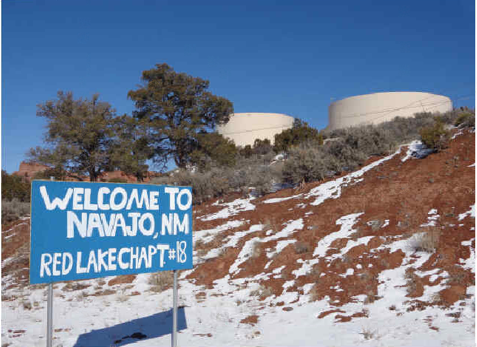Navajo Nation Thawing Out From Devastating Winter
The Navajo Nation is finally emerging from Operation Winter Freeze, an unprecedented weather-related state of emergency in which more than 3,000 homes lost water due to frozen and broken pipes.
The disaster stemmed from a run in late December and January when nighttime temperatures hovered at around 20 below and daytime temperatures stayed below freezing. “It’s not unusual for temperatures to drop into the negative 20s,” said Erny Zah, spokesman for Navajo Nation President Ben Shelly. “What’s unusual is that it happened for nearly three weeks consecutively. It got to the point where some of us were talking about 15 degrees being warm.”
As a result, the ground froze to a lower depth than it normally does and froze buried water pipes, which started a cascade of breaks—as soon as workers would get a section of pipe thawed, the water would rush to the next frozen section and cause a break there. The freeze reached all the way up to the ends of the lines, freezing hundreds of meters at homes. The bursts and leaks drained millions of gallons from water tanks, depleting pressure system-wide in some cases and threatening the closure of some essential facilities, including a hospital in Fort Defiance, Arizona. The disaster struck far and wide across the Navajo Nation, from Tuba City, Arizona and southern Utah’s Navajo Mountain in the west to Window Rock and Crownpoint, New Mexico in the east.
The governors in both Arizona and New Mexico declared states of emergency due to problems created by the extreme temperatures. More than 3,500 homes reported water outages, and by the third week in February water had been restored to two thirds of those. The crisis wiped out $780,000 in the Navajo Tribal Utility Authority’s (NTUA) rate-derived contingency fund, and Shelly is seeking $2.8 million more to cover ongoing work by both authority crews and those visiting from other agencies on and off the reservation.
In addition to asking for funds from its tribal council and a hodgepodge of tribal, state and county agencies, the Navajo Nation has a new source of support in the federal government. The tribe is working on its own emergency declaration, made possible when President Obama amended the Stafford Act on January 29 to allow federally recognized tribes to seek a federal emergency or major disaster declaration directly from the president. “A lot of tribes are watching us to see how we handle this,” Zah said. “It’s a brand-new process. It’s something that has never been done in U.S. history.”
Tribal personnel have been working with the Federal Emergency Management Agency to quantify disaster-related costs, and they expect to appeal to the president in late February for funds.
Rex Kontz, deputy general manager for the Navajo Tribal
Utility Authority, said that although many of the frozen
pipes were installed in the 1950s, the freak weather was
much more to blame than any engineering shortfalls. For
starters, most of the pipes are buried at a safe depth of
three to four feet beneath the surface. “We’ve discovered
some pipes that are shallow, from people who have regraded
roads or from erosion,” he said. “But we had some pipes at
normal depth that were freezing, big control valves that
just completely split and cracked. In the 26 years I’ve been
at [the authority], I’ve never seen a main line freeze at
that depth.”
Kontz said pipes installed before the 1960s were laid by the
Navajo Nation or the Bureau of Indian Affairs, and after
that, Indian Health Service took over. He worked with the
Indian Health Service in the 1980s, and at that time they
were using PVC pipes, which withstand freezing better than
older, galvanized iron pipes that underlie most of the
reservation—including the tribal office complex.
To some extent, he said, the pipes that were likely to be problematic have now been revealed—that is, busted. To revamp all the old, at-risk piping could cost close to copy billion. “It’s something we’re going to have to scale over years,” Kontz said.
Meanwhile, 15 Navajo utility crews, plus eight from the Navajo Engineering and Construction Authority and two from the Salt River Project in Phoenix, have been fixing pipes; and most remaining jobs are in the most remote areas. The freezing temperatures and snow of weeks past have given way to much warmer days, so getting work equipment stuck in mud has become a regular challenge. Often it takes a crew an entire day to restore water to a single home.
Lydia A. Lee, an elder in the eastern Navajo community of Red Gap, waited two weeks for a crew to fix the broken pipe outside her home. She had to buy bottled water for drinking 30 miles away in Fort Defiance, and needed a donation of wash water from her church. On the bright side, her pipes might be more reliable than before, said NTUA engineer Jason Corral.
As for the crews slogging through the mud to restore water to Navajo Nation residents, they seem more than willing to help. Zah noted that federal safety regulations limit workers to 75 hours a week, and up to 15 hours a day. “They’re hard workers,” he said. “They’d work more if they could.”
Their sacrifice and dedication can be seen in Rico Burbank, a young Navajo utility pipe-layer who has a newborn at home with his wife in Chinle, Arizona. He said it has been hard to be away from his 3-month-old son, but he seems resigned to answering the call of duty. “I see him once a week,” he said. “Every Friday I go home, see him and come back to work again.”
Read more at http://indiancountrytodaymedianetwork.com/2013/03/04/navajo-nation-thawing-out-devastating-winter-147975

